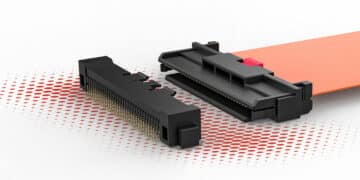The Y-Lock Pullforce connector system from Yamaichi Electronics is the reliable and process-safe solution for applications with high requirements, especially for battery management or cell contacting systems in the automotive industry. The system will now be extended by version V4 with Connector Position Assurance and integrated contact protection for the FFC/FPC.
The Pullforce System (Non-ZIF) of the Y-Lock features the intelligent One-Push locking mechanism, which is available in different versions. Here, the flexible flat cable (FFC) or the flexible printed circuit board (FPC) is inserted into the connector using the pre-assembled stiffener. In the V3 and V4 versions, the stiffener automatically engages in two steps, first via lateral locking hooks and in the next step via the double front locking.
Blind plugging and contacting possible
Thanks to the guide pins on the system, blind plugging and contacting is also possible. This blind mating is particularly advantageous for applications that are difficult to access or where space is limited. The connection is disconnected by simply pulling out the FFC/FPC – mechanical actuation of the connector is not required.
The Y-Lock version 3 has already successfully established itself in the market. Due to the double locking, the blind mating function and the low profile of 3.9mm, this solution is suitable for battery systems where the FFC/FPC is not under voltage after disconnection from the connector. The Y-Lock system has been qualified based on LV214.
Y-Lock Version 4 with CPA – Connector Position Assurance
The next stage of development of the Y-Lock series is the V4 version. The connector has an optional Connector Position Assurance (CPA) that provides additional locking of the cable side with the connector. The CPA is located on the stiffener side and latches with the connector when actuated. The FFC/FPC can only be released after the CPA has been unlocked. Of course, the V4 also has the front and side locking with pullforce function, so that secure locking is ensured even without CPA.
Another advantage of Y-Lock V4 is the integrated contact protection in the contact area of the FFC/FPC. This protection ensures that the FFC/FPC is covered by the stiffener from all four sides and that there is no danger if the cable is still under voltage after it has been released.
With V4 the contact distances of e.g., 1.3 mm or 1.8 mm can be individually adapted to the requirements for clearance and creepage distances. All versions are available with different pitches and a range of pin counts. Due to the low profile height of 4.5mm, the Y-Lock V4 is the right choice especially for applications where space is critical.



















